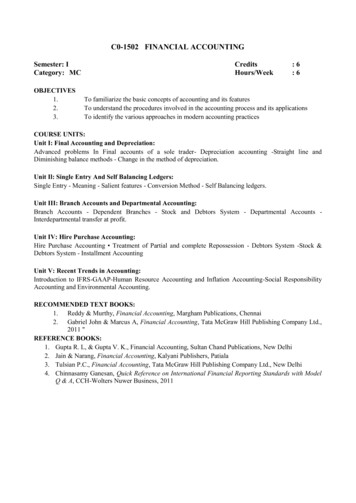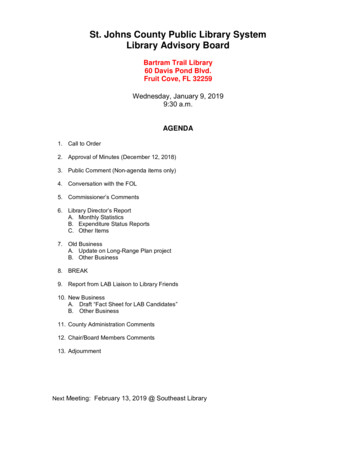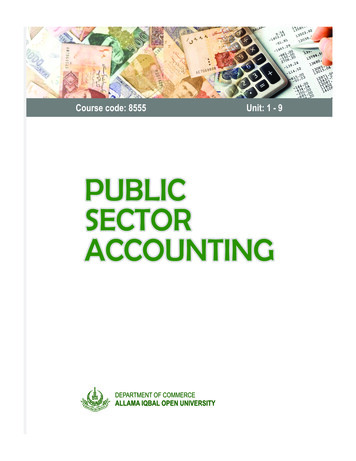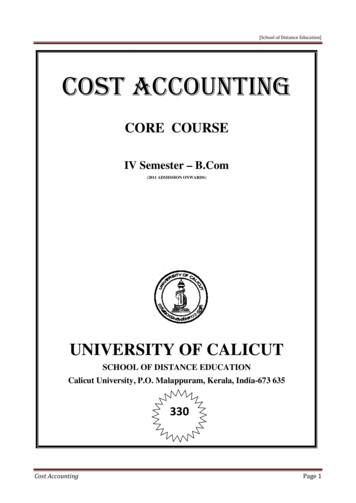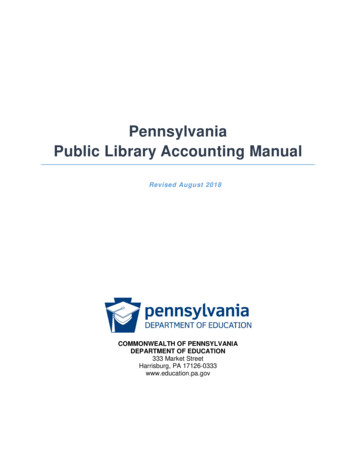
Transcription
PennsylvaniaPublic Library Accounting ManualRevised August 2018COMMONWEALTH OF PENNSYLVANIADEPARTMENT OF EDUCATION333 Market StreetHarrisburg, PA 17126-0333www.education.pa.gov
Commonwealth of PennsylvaniaTom Wolf, GovernorDepartment of EducationPedro A. Rivera, SecretaryOffice of Commonwealth LibrariesGlenn R. Miller, Deputy SecretaryBureau of Library DevelopmentVacantThe Pennsylvania Department of Education (PDE) does not discriminate in its educational programs,activities, or employment practices, based on race, color, national origin, [sex] gender, sexual orientation,disability, age, religion, ancestry, union membership, gender identity or expression, AIDS or HIV status, orany other legally protected category. Announcement of this policy is in accordance with State Lawincluding the Pennsylvania Human Relations Act and with federal law, including Title VI and Title VII ofthe Civil Rights Act of 1964, Title IX of the Education Amendments of 1972, Section 504 of theRehabilitation Act of 1973, the Age Discrimination in Employment Act of 1967, and the Americans withDisabilities Act of 1990.The following persons have been designated to handle inquiries regarding PDE’s nondiscriminationpolicies:For Inquiries Concerning Nondiscrimination in Employment:Pennsylvania Department of EducationEqual Employment Opportunity RepresentativeBureau of Human Resources333 Market Street, 11th Floor, Harrisburg, PA 17126-0333Voice Telephone: (717) 787-4417, Fax: (717) 783-9348For Inquiries Concerning Nondiscrimination in All Other Pennsylvania Department ofEducation Programs and Activities:Pennsylvania Department of EducationSchool Services Unit Director333 Market Street, 5th Floor, Harrisburg, PA 17126-0333Voice Telephone: (717) 783-3750, Fax: (717) 783-6802If you have any questions about this publication or for additional copies, contact:Pennsylvania Department of EducationBureau of Library Development Office of Commonwealth Libraries607 South Drive, Room 221, Harrisburg, PA 17120-0600Voice: (717) 787-3124, Fax: (717) 772-0044www.statelibrary.pa.gov/LSTAAll Media Requests/Inquiries: Contact the Office of Press & Communications at (717) 783-9802This manual is made possible in part by Library Services and Technology Act (LSTA) funds from the U.S.Institute of Museum and Library Services and through Library Access Funds administered by the Office ofCommonwealth Libraries, Department of Education, Commonwealth of Pennsylvania, Tom Wolf,Governor.Revised August 20182
Table of ContentsCHAPTER 1 – INTRODUCTION . 7100 INTRODUCTION . 7101 STATEMENT OF PURPOSE . 7CHAPTER 2 – OVERVIEW OF ACCOUNTING OPERATIONS &ORGANIZATION OF PENNSYLVANIA PUBLIC LIBRARIES . 9200 ORGANIZATION OF PUBLIC LIBRARIES . 9201 OVERVIEW OF ACCOUNTING MANUAL TOPICS . 9CHAPTER 3 – OVERVIEW OF GENERAL ACCOUNTING PRINCIPLES. 12300301302303304305306307308309310311CHAPTER OBJECTIVE/SUMMARY. 12PURPOSE OF ACCOUNTING. 12SIGNIFICANT ACCOUNTING TERMS AND CONCEPTS . 12FUNCTION OF ACCOUNTING . 14BASIS OF ACCOUNTING . 16ACCOUNTING RECORDS . 16DOUBLE-ENTRY ACCOUNTING . 19JOURNAL ENTRIES . 20MAINTAINING A GENERAL LEDGER . 21CHART OF ACCOUNTS . 21ELECTRONIC VS. MANUAL ACCOUNTING SYSTEMS . 22ACCOUNTING POLICIES . 22CHAPTER 4 – ACCOUNTING FOR NONPROFIT LIBRARIES . 24400 CHAPTER OBJECTIVE/SUMMARY . 24401 DEFINITION/OVERVIEW OF NONPROFIT ORGANIZATIONS . 24402 ACCOUNTING STANDARDS AND GOVERNING HIERARCHY . 26403 FINANCIAL REPORTING REQUIREMENTS . 28404 ACCOUNTING FOR REVENUE AND RELATED ASSETS AND LIABILITIES . 34405 ACCOUNTING FOR EXPENSES . 38406 ACCOUNTING AND RECORDING FOR ACCOUNTS PAYABLE AND ACCRUEDEXPENSES. . 40407 ACCOUNTING FOR FIXED ASSETS . 42408 ACCOUNTING FOR COLLECTIONS . 43409 LIBRARY BOOKS AND AUDIO/VISUAL . 44410 DEPRECIATION . 44411 ACCOUNTING FOR INVESTMENTS . 46412 ACCOUNTING FOR DEBT . 48Revised August 20183
CHAPTER 5 – PAYROLL . 51500 CHAPTER OBJECTIVE/SUMMARY. 51501 TYPES OF PAYROLL TAXES . 51502 TAXES WITHHELD FROM THE EMPLOYEE’S PAY . 51503 TAXES PAID BY THE EMPLOYER DIRECTLY AS AN EXPENSE . 52504 FREQUENCY OF TAX DEPOSITS . 53505 REPORTING REQUIREMENTS AND DUE DATES . 54506 OTHER FORMS REQUIRED TO BE FILED OR COMPLETED . 55507 CALENDAR OF RETURNS AND DUE DATES . 56508 PAYROLL BANKING . 58509 PAYROLL ACTIVITIES . 59510 RECORDKEEPING ALTERNATIVES . 60511 DIRECT DEPOSIT . 64512 INDEPENDENT CONTRACTORS . 65513 FMLA . 66CHAPTER 6 – BUDGETING . 67600601602603604CHAPTER OBJECTIVE/SUMMARY. 67DEFINITION AND DEVELOPMENT OF A BUDGET. 67IMPORTANCE OF A BUDGET . 67BUDGET DEVELOPMENT . 68BEST PRACTICES FOR BUDGET REVISIONS . 73CHAPTER 7 – AUTOMATED TOOLS . 74700701702703704CHAPTER OBJECTIVE/SUMMARY. 74ADVANTAGES OF COMPUTERIZING THE LIBRARY ACCOUNTING FUNCTIONS. 74SELECTING AN ACCOUNTING SOFTWARE PACKAGE . 77HARDWARE CONSIDERATIONS . 81POPULAR ACCOUNTING SOFTWARE AND OBTAINING SOFTWARE INFORMATION82705 EVALUATION AFTER INSTALLATION . 83CHAPTER 8 – TAX CONSIDERATIONS . 84800801802803804CHAPTER OBJECTIVE/SUMMARY. 84WHAT IS A 501(C)(3) EXEMPT LIBRARY? . 84UNRELATED BUSINESS INCOME . 85FEDERAL FILING REQUIREMENTS . 86PENNSYLVANIA – TAX AND FILING REQUIREMENTS . 87CHAPTER 9 – INTERNAL CONTROLS . 90900 CHAPTER OBJECTIVE/SUMMARY. 90901 DEFINITION OF INTERNAL CONTROLS . 90902 CONTROL OBJECTIVES . 90Revised August 20184
903904905906907COMPONENTS OF RISK MANAGEMENT . 91INFORMATION TECHNOLOGY CONTROLS . 94WHAT CONTROLS ARE NECESSARY? . 94COMMON INTERNAL CONTROL ISSUES . 95INTERNAL CONTROL QUESTIONNAIRE . 95CHAPTER 10 – AUDIT CONSIDERATIONS. 96100010011002100310041005100610071008CHAPTER OBJECTIVE/SUMMARY. 96TYPES OF FINANCIAL STATEMENT SERVICES . 96TYPES OF AUDITS . 97TYPES OF OPINIONS IN AUDIT REPORTS . 98AUDIT FREQUENCY REQUIRED TO OBTAIN STATE AID . 99AUDITOR SELECTION. 99AUDIT AND REVIEW COST. 101PREPARING FOR THE AUDIT . 102DISTRIBUTION OF AUDIT REPORTS . 102CHAPTER 11 – FREQUENTLY ASKED QUESTIONS . 1031100 CHAPTER OBJECTIVE/SUMMARY. 103CHAPTER 12 – NONPROFIT FUNDRAISING . 1121200 GIFT ACCEPTANCE POLICY . 1121201 ACCOUNTING FOR FUNDRAISERS . 1131202 GAMES OF CHANCE . 114APPENDIX A SAMPLE AUDIT REPORTS . 118A.1 SAMPLE AUDIT (ACCRUAL BASIS) . 118SAMPLE REVIEW COVER PAGE THROUGH ACCOUNTANT’S REPORT (ACCRUAL BASIS)134A.3 SAMPLE AUDIT (MODIFIED CASH BASIS) . 138APPENDIX B . 148B.1B.2ACCOUNTING SOFTWARE SET-UP . 148REPORTS . 151APPENDIX C . 153INTERNAL CONTROL QUESTIONNAIRE. 153BIBLIOGRAPHY . 168CHAPTER 3 . 168CHAPTER 4 . 168CHAPTER 5 . 169CHAPTER 6 . 171CHAPTER 7 . 171Revised August 20185
CHAPTER 8 . 171CHAPTER 9 . 172CHAPTER 10 . 173CHAPTER 11 . 173CHAPTER 12 . 173APPENDIX B . 174APPENDIX C. 174The following Chapter Appendices are independent Microsoft Excel files located outside of thismanual.Chapter #3 – Example #1 – Cash Receipts JournalChapter #3 – Example #2 – Cash Disbursement JournalChapter #3 – Example #3 – Accounts Receivable JournalChapter #3 – Example #4 – Accounts Payable JournalChapter #3 – Example #5 – Payroll JournalChapter #3 – Example #6 – General Journal TemplateChapter #3 – Example #7 – Bank Reconciliation TemplateChapter #3 – Example #8 – Chart of Accounts MappingChapter #4 – Example #1 – Financial StatementsChapter #4 – Example #2 – AP Aging ReportChapter #5 – Example #1 – Earnings RecordChapter #6 – Example #1 – Template - BudgetChapter #6 – Example #2 – Budget – Monthly BreakdownRevised August 20186
CHAPTER 1 – INTRODUCTION100Introduction100.1This manual is intended to be of primary benefit to small, nonprofit libraries 1 that do not havefull-time bookkeepers or accountants. For this reason, the manual’s main focus is to illustratebasic accounting principles in layman’s terms and to provide instructions for accessingresources online. However, larger libraries may also benefit from the accounting policies,procedures, and processing methods discussed in this manual.100.2This accounting manual replaces the Pennsylvania Public Library Accounting Manual datedSeptember 2010.100.3Libraries will be able to use this manual as a teaching and implementation aid. Additionally, themanual will enable uniform financial accounting by all public libraries within Pennsylvania. Allsections of this manual should be carefully studied and understood prior to implementing anysystems described.101Statement of Purpose101.1The purpose of this manual is to provide guidance to Board of Directors/Trustees (Board) andlibrary staff who do not have an accounting background in establishing accounting practices andinstituting appropriate internal controls that facilitate:1. Compliance with requirements of external entities (Commonwealth, municipal, andfederal requirements); and2. Compliance with and development of internal guidelines (Board and management).101.2This manual will also serve as a reference tool and link to key guidance when accountingrelated questions arise.101.3This manual will help public libraries:1. Establish a system of recording financial transactions;2. Produce accurate, consistent, and understandable financial reports;3. Provide reasonable assurance as to the financial integrity of library operations via theestablishment of a system of internal controls;4. Complete the Pennsylvania Department of Education (PDE) Office of CommonwealthLibraries’ (OCL) and public library’s public annual report;5. Keep audit costs to a minimum;1Small, nonprofit libraries are defined as those that receive 50,000 or less in annual funding from theCommonwealth of Pennsylvania.Revised August 20187
6.7.8.9.Comply with various local, state, and federal tax requirements;Understand payroll tax requirements;Consider the purchase of accounting software; andAnswer commonly asked questions.101.4This manual can be utilized by the library Board and staff as follows:1. Improving decision-making capabilities regarding the operations of the library based onadequate and accurate financial information;2. Establishing policies and procedures regarding recording and reporting financialinformation;3. Establishing policies and procedures related to safekeeping of library resources; and4. Providing a simplified guide based on library best practices for the individuals who areresponsible for the recording and processing of financial data.Revised August 20188
CHAPTER 2 – OVERVIEW OF ACCOUNTING OPERATIONS &ORGANIZATION OF PENNSYLVANIA PUBLIC LIBRARIES200Organization of Public Libraries200.1Public libraries in Pennsylvania may be organized in any one of the following forms:1. Nonprofit entity;2. Government entity; and3. Combination of a nonprofit and a governmental entityThe organization form of a public library is important since different accounting principles applydepending on the type of the organization.200.2Nonprofit libraries are entities that are usually exempt from federal and state income taxes sincethey are operated exclusively for educational purposes and no part of their earnings are used tobenefit any private shareholders or individuals. They may be subject to income tax on incomethat is derived from activities not related to their exempt purpose (see Chapter 8). Nonprofitlibraries follow accounting principles specific to nonprofit entities (see Chapter 4).200.3Government libraries are owned and operated by city, borough, township, or countygovernments or other political subdivisions. A majority of the funding for a governmental libraryis provided from public funds. Governmental libraries are not required to pay taxes. Additionally,governmental libraries follow accounting principles specific to governmental entities. Thismanual does not cover governmental accounting. For government libraries, the applicablemunicipality is responsible for accounting and any questions or concerns should be directed tothe municipality200.4A library that is a combination of governmental and nonprofit type entities should follow theaccounting principles applicable to the form of organization that most closely resembles thelibrary. For example, if the library has most of the characteristics of a governmental entity, thenthe accounting principles applicable to governmental libraries should be followed.200.5Library Board members or personnel who have questions regarding how to determine the entitytype of the library should discuss how to determine this with their District Library Consultant orlegal counsel.201Overview of Accounting Manual Topics201.1Accurate accounting and financial reporting are achieved when responsible personnel areaware of and know where to reference the accounting principles specific to their industry. Inaddition, adequate internal controls should be in place to safeguard assets, promote operationefficiencies, enable adherence to prescribed accounting policies, and confirm the accuracy andreliability of accounting data.Revised August 20189
201.2It is the objective of this manual to provide the responsible personnel of Pennsylvania publiclibraries with the information and guidance to reference materials they need to create andmaintain an accounting environment that is accurate and reliable.201.3Chapter 3 – Overview of General Accounting Principles and Chapter 4 – Accounting forNonprofit Libraries provides readers with a simplified how-to approach to basic accountingprinciples and processes in easy to understand terminology. It answers the questions of “Why?”by describing the function and purpose of accounting; “What?” by providing information on thebasic books of entry, the general ledger, and the chart of accounts; and “How?” including abasic overview of how items are recorded.201.4Payroll and related taxes and employee benefits are a complex area of accounting. Chapter 5 –Payroll provides best practices, guidance for preparing payroll internally, and selecting andutilizing an external payroll provider.201.5Budgets are essential to the planning and oversight of a library. Chapter 6 – Budgeting providesreaders with an understanding of the importance of a budget, its uses, and steps to take inpreparing an accurate and meaningful budget.201.6Chapter 7 – Automated Tools provides information on automated tools, and necessaryconsiderations for purchasing accounting software.201.7Although libraries are generally exempt from tax, there are certain instances where a nonprofitorganization is subject to tax on unrelated business income. Chapter 8 – Tax Considerationsreviews the implications of unrelated activities and when a library may be required to pay thesetaxes.201.8Chapter 9 – Internal Controls discusses the importance of adequate controls, what types ofcontrols should be implemented, and provides sample checklists to reference.201.9Chapter 10 – Audit Considerations discusses when reviews and audits are necessary, auditrequirements, and how a library can prepare and reduce costs.201.10Chapter 11 – Frequently Asked Questions provides guidance on some specific accountingquestions that libraries encounter.201.11Chapter 12 – Nonprofit fundraising provides guidance on fundraising as it relates to accountingand audits.Revised August 201810
201.12Following the chapters providing specific detail relating to accounting and operations, there area series of Appendices sections (Appendix A – C) that provide sample audits, financial reviews,QuickBooks set-up information, and internal control questionnaires.The Microsoft Excel files that are referenced as chapter examples are located outside of themanual as independent files on the PDE OCL website.Revised August 201811
CHAPTER 3 – OVERVIEW OF GENERAL ACCOUNTING PRINCIPLES300Chapter Objective/Summary300.1The purpose of this chapter is to provide the reader with a simplified, how-to approach toaccounting principles and preparation of financial reports. A brief outline of the chapter follows:301. Purpose of Accounting302. Significant Terms and Concepts303. Function of Accounting304 Basis of Accounting305. Accounting Records306. Double-Entry Accounting307. Journal Entries308. Maintaining a General Ledger309. The chart of accounts310. Electronic vs. Manual Accounting Systems311 Accounting Policies300.2This manual is not designed as an accounting course; it is intended to serve as a high-level,how-to guide for library personnel without an accounting background. Further training or study isneeded to fully understand the accounting concepts/terms presented and more complicatedaccounting principles.301Purpose of Accounting301.1There are two primary purposes for maintaining accounting records:1. To fairly and accurately represent the financial position and results of the library’soperations; and2. To document the library’s compliance with the laws and regulations of the federal, state,and local governments.Contributors, trustees, Board members, employees, creditors, and government entities all relyon the library’s accounting records to help with decisions that impact a library’s future andobjectives.302Significant Accounting Terms and Concepts302.1It is important to understand commonly used terminology and accounting terms to help applyaccounting principles.Revised August 201812
Resources providing definitions of commonly used terms include:1. NYS Society of CPAs 2 for a glossary of accounting terms; and2. Accounting for Management 3 for accounting terms.It is recommended you consult these resources when you encounter a term with which you arenot familiar.Some of the most common terms are:1. Account Payable – Amount owed to a creditor for a delivered good or completedservice.2. Accounting Equation – The following formula is the heart of double-entry accounting:Assets Liabilities Equity3.4.5.6.7.8.9.As a result, an increase in assets must be accompanied by an equal increase inliabilities and/or capital. The Statement of Financial Position (i.e. Balance Sheet)illustrates the accounting equation. For example, if a printer is purchased, and not paidfor up front with cash, you have the printer in your possession and must record it as anasset. However, you are still liable to pay for the printer, so until you pay the vendor,there must be a liability for the cost of the printer on the Balance Sheet.Accrual – The recognition of an expense or revenue that has occurred but has not yetbeen recorded.Accrual Accounting – The attempt to record the financial effects of transactions andother events in the periods in which those transactions or events occur rather than onlyin the periods in which cash is received or paid by the library, using the techniquesdeveloped by accountants to apply the matching principle.Asset – An economic resource that is expected to be of benefit in the future (e.g. cash,inventory). Probable future economic benefits obtained as a result of past transactions orevent. Anything of value to which the firm has a legal claim.Balance Sheet (Statement of Financial Position) – A report that details the variousassets and liabilities of a library at a point of time (e.g. end of year). The Balance Sheetmust always balance (e.g. assets equal liabilities plus equity).Debit/Credit – Debit always refers to the left side of a journal entry and credit alwaysrefers to the right side of a journal entry.Designated Fund – Used to account for funds that are designated or restricted to theuse specified by the donor – usually for a particular purpose or project.Endowment – Is any asset donated to and for the perpetual benefit of a nonprofitinstitution. The donation is usually made with the requirement that the principal remainintact and money earned from investing the principal be used for a specific purpose.2"Accounting Terminology Guide - Over 1,000 Accounting and Finance Terms," New York State Societyof CPA's, accessed July 19, 2018. ountingterminology-guide#sthash.NyHnOeEH.dpbs.3 "Accounting Equation," Financial Accountancy, accessed July 19, ng-and-accounting/accounting-equation/.Revised August 201813
10. Equity or Fund Balance – The net assets of the library after all creditors have beenpaid off (e.g. assets – liabilities equity).11. Expense – Items the library pays for (e.g. office supplies, electricity etc.).12. Financial Statements – Presentation of financial data, including Statement of FinancialPosition (i.e. Balance Sheet/Statement of Financial Position, income statement,statement of cash flows, and any other supporting statements that are intended tocommunicate an organization’s financial position at a point of time (e.g. end of year).13. General Fund – Used to account for all assets and liabilities of the library except thoseparticularly assigned for other purposes in another more specialized fund. It is theprimary operating fund for the library.14. Income Statement (Statement of Revenue and Expense) – A report summarizing theeffect of revenues and expenses over a period of time.15. Journal Entry – Method for recording transactions. Journal entries always have twosides (debit and credit).16. Liability – Amount owed to third parties, including suppliers, banks, tax authorities, andemployees.17. Loss – Excess of expenditures over revenue for a reporting period (e.g. revenues –expenses when expenses are greater than revenues).18. Profit – The excess of revenues over cost for a reporting period (e.g. revenues –expenses when expenses are lower than revenues).19. Revenue – Sales and other earnings (e.g. fundraising and interest).20. Statement of Cash Flows – Under the accrual basis of accounting, revenue, andexpenses are not always recognized when cash is received or paid. The statement ofcash flow provides a report of the sources and uses of cash. Essentially, the cash flowstatement shows readers where cash came from and where cash went.21. Statement of Financial Position (Balance Sheet) – A report that details the variousassets and liabilities of a library at a point of time (e.g. end of year). The Balance Sheetmust always balance (e.g. assets equal liabilities plus equity).22. Subsidiary Ledger – A ledger where supporting accounts are kept in addition to thegeneral ledger (e.g. accounts payable journal).23. Transaction – A recording of the movement of economic resources (e.g. when a librarypurchases supplies, money is transferred out of the cash account and the new economicresource is received (e.g. supplies) and recorded in the appropriate account).303Function of Accounting303.1There are four main steps in the accounting function:1.2.3.4.Obtain financial information;Record financial information;Analyze financial information; andPresent financial informationRevised August 201814
303.2Obtain Financial Information:The first of the four main functions of an accounting system is obtaining financial information.The information is generally obtained from transactions and the documentation that supportsthose transactions. For example, revenue from fines would be obta
basic accounting principles in layman's terms and to provide instructions for accessing resources online. However, larger libraries may also benefit from the accounting policies, procedures, and processing methods discussed in this manual. 100.2 . This accounting manual replaces the . Pennsylvania Public Library Accounting Manual. dated .




